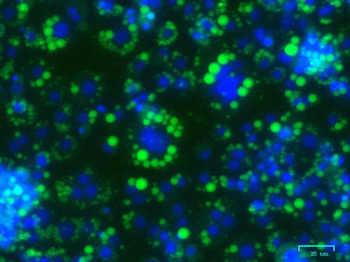Cellular and molecular pathways driving Thyroid eye disease (TED)

Orbital Adipocytes
TED, also referred to as Graves’ ophthalmopathy is the most common orbital pathology in the world. TED is an autoimmune disease that occurs in approximately half of patients with Graves’ disease. In TED, the tissues surrounding the eye (the orbit) become inflamed and ultimately remodel to form excessive fat deposits, scar tissue or a combination of both. Autoantibodies in TED activate orbital fibroblasts, which are the key effector cells in the disease, to form either adipocytes (type I disease) or scar-forming myofibroblasts (type II disease). It is unclear how TED develops and why in some patients, tissue remodels as fat, as scar tissue, or a mixture of both. We study molecular pathways in orbital fibroblasts from TED patients to understand the pathobiology of disease and identify new targets that may help treat and even cure TED.